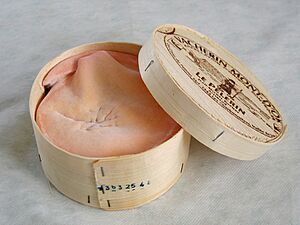Vacherin facts for kids
Quick facts for kids Vacherin |
|
|---|---|
 |
|
| Country of origin | France, Switzerland |
| Region, town | Franche-Comté, and Vallée de Joux (canton of Vaud) |
| Source of milk | Cows |
| Pasteurized | Traditionally, no |
| Texture | washed rind soft cheese |
| Aging time | 5-7 weeks |
| Certification | AOC France 1981; PDO France 1996; |
| Named after | Lua error in Module:Wikidata at line 70: attempt to index field 'wikibase' (a nil value). |
Vacherin is a special type of cheese made from cow's milk. The name 'Vacherin' comes from the French word vache, which means 'cow'. There are two main kinds of Vacherin cheese. One comes from France and the other from Switzerland.
Contents
Mont d'Or Cheese: A Winter Treat
One popular type is called Mont d'Or. In France, it's also known as Vacherin du Haut-Doubs. In Switzerland, people often call it Vacherin Mont-d'Or or just Vacherin.
This cheese is soft and creamy. It's made from cow's milk in Switzerland or France. You'll find it in villages in the Jura Mountains region. This area has been officially recognized for making this cheese since 1981.
Mont d'Or has a grayish-yellow rind that is washed during its making. It is a seasonal cheese, meaning it's only made at certain times of the year. Production happens between August 15 and March 15. You can buy it from September 10 to May 10.
How Mont d'Or is Made
Swiss Vacherin Mont d'Or is usually made with milk that has been thermized. This means the milk is heated gently to kill some germs, but it's not fully pasteurized. French Vacherin du Haut-Doubs is made with unpasteurized milk. This means the milk is used raw, without heating.
This cheese is traditionally made in the colder months. This is when cows come down from the high mountain pastures. At this time, there isn't enough milk to make larger cheeses like Comté cheese.
Mont d'Or cheese is sold in round wooden boxes. These boxes are made from spruce wood. Special workers called "sanglier" collect the spruce strips. People often warm the cheese in its box. Then, they eat it like a fondue, scooping out the melted cheese.
In France, the official rules (called AOC/PDO) allow two ways to make Mont d'Or. It can be made by small, traditional producers (Artisanal). Or it can be made by groups of farmers working together (Coopérative).
Vacherin Fribourgeois: A Firmer Swiss Cheese
The other main type of Vacherin is a firmer Swiss cheese. It is called Vacherin Fribourgeois. This cheese is made in the canton of Fribourg in Switzerland. This is the same area where Gruyère cheese comes from.
Vacherin Fribourgeois has a slightly tangy, pine-like taste. Its flavor can be mild or strong, depending on how old it is. This cheese is also a key ingredient in many fondue recipes. It gives fondue a special taste.
Varieties of Vacherin Fribourgeois
Vacherin Fribourgeois has official Swiss AOC status. There are six different types you can find:
- Classic: This cheese is aged for 6 to 12 weeks.
- Extra: This one is aged for at least 12 weeks.
- Rustic: Aged for at least 12 weeks, but can be aged up to 25 weeks (about 6 months).
- Alpage: This type is aged for 12 to 25 weeks.
- Mountain: Aged for 9 to 25 weeks.
- Bio (Organic): This organic version is aged for at least 9 weeks.
As Vacherin Fribourgeois gets older, it can develop a stronger smell. This is due to tiny living things (microorganisms) working in the cheese.
Vacherin d'alpage: A Richer Taste
Vacherin d'alpage is a special kind of Vacherin. It is made from the milk of cows that eat grass in high mountain meadows. Because of what the cows eat, this cheese has a much richer and more intense flavor.


